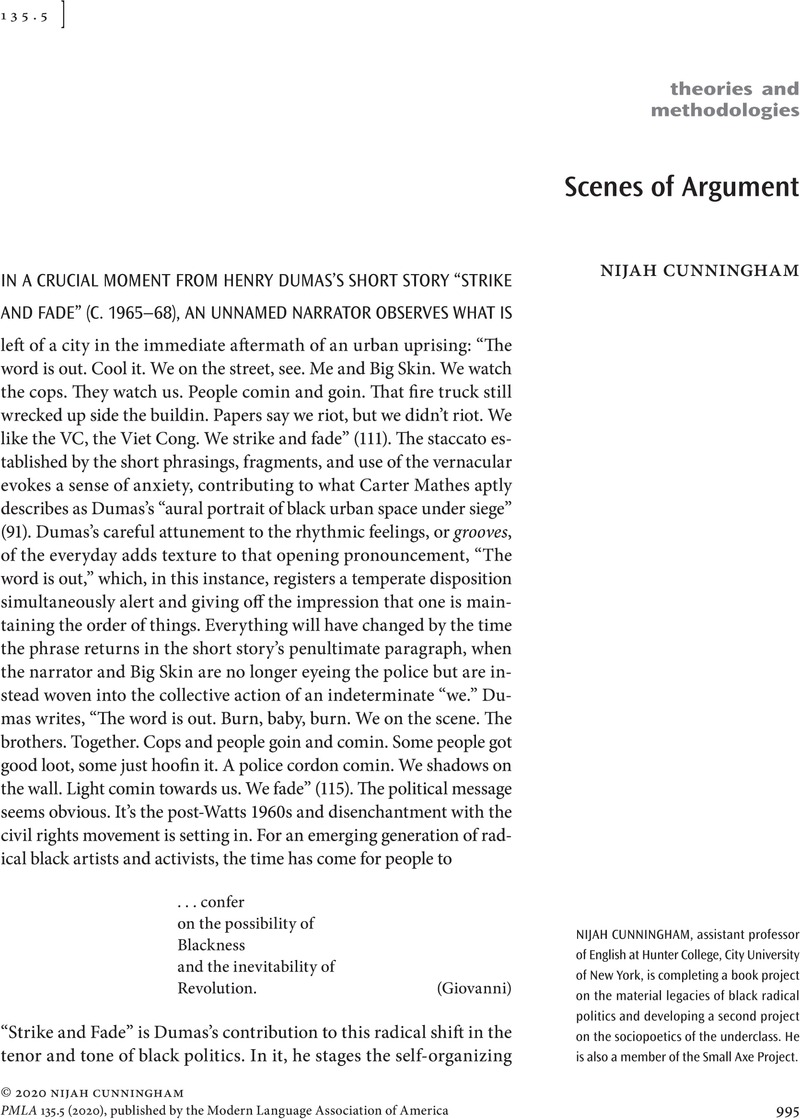No CrossRef data available.
Article contents
Abstract
An abstract is not available for this content so a preview has been provided. Please use the Get access link above for information on how to access this content.

Information
- Type
- Theories and Methodologies
- Information
- Copyright
- Copyright © 2020 Nijah Cunningham
References
Works Cited
Anderson, Amanda. “The Culture of Argument: An Interview with Amanda Anderson.” Interview by David Cerniglia. The Minnesota Review, nos. 71-72, Spring 2009, pp. 87–100.CrossRefGoogle Scholar
Cortez, Jayne, and the Firespitters. Maintain Control. Bola Press, 1986. Sound recording.Google Scholar
Crawley, Ashon. “Resonance: Neutrinos and Black Life.” Critical Ethnic Studies. vol. 3, no. 1, 2017, pp. 48–58.CrossRefGoogle Scholar
Dabashi, Pardis. “The Pressure to Intervene: A Case for the Modest (Young) Critic.” Post-critique and the Profession. MLA Annual Convention, 4 Jan. 2019, Hyatt Regency, Chicago.Google Scholar
Dimock, Wai Chee. “A Theory of Resonance.” PMLA. vol. 112, no. 5, Oct. 1997, pp. 1060–71.Google Scholar
Dumas, Henry. “Strike and Fade.” Echo Tree: The Collected Short Fiction of Henry Dumas, edited by Redmond, Eugene B., Coffee House Press, 2003, pp. 111–15.Google Scholar
Ferreira da Silva, Denise. “Hacking the Subject: Black Feminism and Refusal beyond the Limits of Critique.” philoSOPHIA. vol. 8, no. 1, 2018, pp. 19–41.CrossRefGoogle Scholar
Giovanni, Nikki. “Detroit Conference of Unity and Art (For HRB).” Black Feeling, Black Talk, Black Judgment, Morrow Quill Paperbacks, 1979, p. 3.Google Scholar
Hartman, Saidiya V. Scenes of Subjection: Terror, Slavery, and Self-Making in Nineteenth-Century America. Oxford UP, 1997.Google Scholar
Johnson, Barbara. “The Alchemy of Style and Law.” The Feminist Difference: Literature, Psychoanalysis, Race, and Gender, Harvard UP, 1998, pp. 165–82.Google Scholar
Johnson, Barbara. “Apostrophe, Animation, and Abortion.” Diacritics. vol. 16, no. 1, 1986, pp. 29–47.CrossRefGoogle Scholar
Lordi, Emily J. Black Resonance: Iconic Women Singers and African American Literature. Rutgers UP, 2013.CrossRefGoogle Scholar
Mathes, Carter. Imagine the Sound: Experimental African American Literature after Civil Rights. U of Minnesota P, 2015.Google Scholar
Morrison, Toni. “On Behalf of Henry Dumas.” Henry Dumas Issue, special issue of Black American Forum. vol. 22, no. 2, Summer 1998, pp. 310–12.Google Scholar
Reid, Tiana. “The Context of Intellectual Friendship.” The New Inquiry, 1 Mar. 2018, thenewinquiry.com/the-context-of-intellectual-friendship.Google Scholar
Scott, David. Stuart Hall's Voice: Intimations of an Ethics of Receptive Generosity. Duke UP, 2017.Google Scholar
Spillers, Hortense J. “The Crisis of the Negro Intellectual: A Post-date.” Boundary 2. vol. 21, no. 3, Autumn 1994, pp. 65–116.CrossRefGoogle Scholar
Tomlinson, Barbara. Feminism and Affect at the Scene of Argument: Beyond the Trope of the Angry Feminist. Temple UP, 2011.Google Scholar

